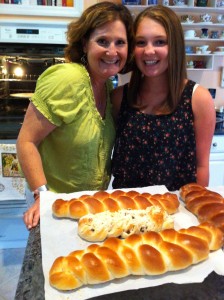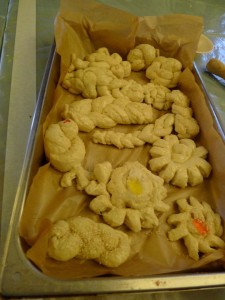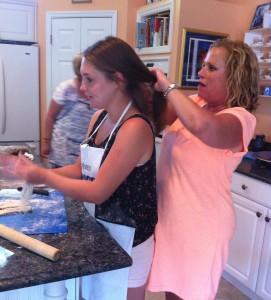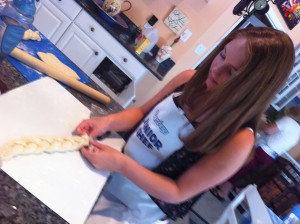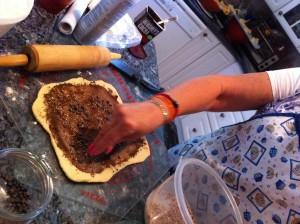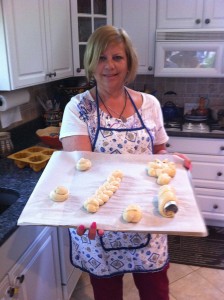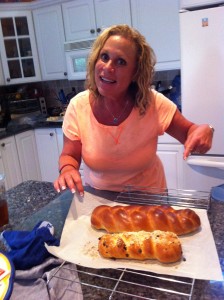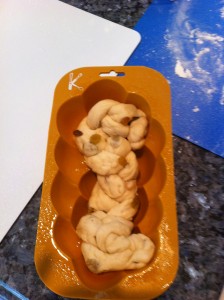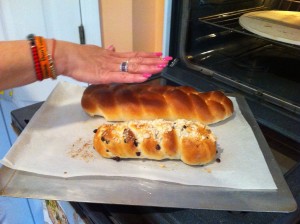JWRP Trip to Israel: The Mitzvah of Making Challah
One of the MANY highlights of my recent JWRP experience was celebrating my first Shabbat in Israel. The best part—making challah in the same room, at the same time, with 200 other wannabe balaboostas who dispel the theory that too many cooks in the kitchen spoil the soup. I felt like I was on the set of Food Network as I watched Rebbetzin Raizy work her magic on the big screen and effortlessly twist the soft dough into shapes of a dove, butterfly, six-strand loaf, napkin rings, a linked loop round challah, and other creations that would make Martha Stuart envious and want to convert.
Even though I took notes on every step, it wasn’t quite that easy when it was my turn to braid a basic three-strand challah and pretended it was my daughter’s ponytail. Like anything worthwhile, it’s  going to take practice. Fortunately, since I’ve been back from my trip, the St. Louis “Soul Sisters” have enjoyed quite a few opportunities to practice the art of challah making.  When I make challah now, I try to remember what I learned in Israel. For one, making these heavenly loaves from scratch is a mitzvah for a woman, and every ingredient and every step means something.
For example, the flour is the ground; the water is the sky; and the yeast symbolizes that everyone who eats challah should rise upward, grow, and expand (like my waistline when I’m tempted to devour the entire bread). Also, a pinch of salt alludes to the temple sacrifices (and enhances flavor), while sugar signifies a wish for a sweet life. The oil anoints us with a prayer.
Anyway, after we watched the challah demonstration, we got our hands dirty. Every table got a big bowl of our own batch, and we dug our fists into the squishy stuff like preschoolers messing with Playdough. As we punched the bread down and kneaded our dough, we used this special time to pray. We took turns saying the name of someone dear to us, and together we said “Amen.†By doing this ritual, we are told, our spirit is added to the bread.
Rebbetzin Raizy reminded us that “the greatest power of speech is prayer.†She must be wise because the noise in the Aish building that Friday morning could have raised the roof.
I also learned that making braided bread on Shabbat is a tangible way to bring together two worlds—spiritual and physical. As described in the Aish website, humans are a combination of body and soul, like flour and water is to challah. We can’t be sustained on bread alone, and we need challah to nourish our spiritual selves. Moreover, the Torah commands us to practice this tradition every week as one of three mitzvot given especially to women.
So who am I to sacrifice carbs for dinner?
Actually, the word “challah” doesn’t mean bread or dough. The root of the word is chol means ordinary or secular, which is precisely what makes challah-making so special for women. What I learned is that moms have the unique ability to take an ordinary, mundane task like making bread and elevating it to something greater, something holy. (Never mind the flour spilled all over the kitchen counter and floor).
The physical act of kneading and braiding dough creates an opening to heaven and allows God into our home. For example, after we make the dough, we are supposed to separate a piece (about the size of a golf ball) and raise it in our hand before we set it aside.
To make it official, say:
“…It shall be that when you eat the bread of the land, you shall set aside a portion [of dough] for God.”
 OR
BA-RUCH A-TAH A-DO-NOI ELO-HAI-NU ME-LECH HA-O-LAM A-SHER KID-SHA-NU B’MITZ-VO-TAV V’TZI-VA-NU L’HAF-RISH CHAL-LAH
Blessed are You, Lord our God, King of the Universe, who has sanctified us with His commandments and commanded us to separate challah.
Imagine Jewish women from all over the world saying these words at the same time. The prayer becomes even more magnified. I know, gives me the chills, or maybe it’s the thermostat not working again.
 “A woman has the power to make every physical thing she does holy, as long as she does it with a good intention,†said Rabbinetz Razzi. In other words, “It’s not what we do; it’s what we’re thinking when we do it.â€
So, it’s actually what we think in our minds when we are making challah that makes it a mitzvah. I get it. By the way, this applies to any domestic task, whether we rinse dishes in the sink, fold the laundry, or sweep the floor. These chores have to be done anyway, so you might as well thank God that you have food to eat, clothes to wear, and a roof over your head every time you load the dishwasher, bleach your husband’s stained undershirts, and clean the crumbs out of the toaster oven.  If we think of our house as a holy temple, we can bring God into our life. Like our matriarch Sarah, we have the gift to make the mundane a mitzvah.
So, fast forward…
I looked forward to my second Shabbat  since I returned home from Israel, and I wanted to make my own challah again. This time, I got a private lesson in the lovely home of our St. Louis Madricha Peggy, who shared her secrets with me last week. A grandma of six, ages 6 1/2 years old on down, this New York native has been making challah since her own kids were in grade school, so she’s an excellent teacher. On Thursday we made the dough, and on Friday we made the breads, so it was a two-day process. Of course, challah can be made in one day, but this worked better with our schedule.
While some people like to use their hands the way God intended, we pressed the easy button and used a commercial electric mixer. I took notes while Peggy showed me how to dilute the yeast and warm water, feeling the temperature so it was pleasant like a baby’s bath. I felt like I was doing a science experiment as I watched the mixture start to foam and form craters at the bottom of the bowl. The fresh aroma of yeast started to fill the air and put us in the mood to celebrate Shabbat.
In a glass measuring cup, Peggy added ½ cup honey, 1/2 cup oil, 1/3 cup sugar, and 3 eggs. Then she alternated flour with these wet ingredients. It was a nasty, humid day in St. Louis, and the dough was still a little sticky, so she kept adding more flour until it left an indent when she poked it like a Pillsbury dough boy. Secret #1. Using the big silver dough hook, she continued to knead the dough for about five minutes until a ball formed and the bowl was practically scraped clean. Secret #2.
Next, Peggy put the dough in a jumbo size plastic bag that she coated with cooking spray. She also left air in the bag for room to grow, and gave the bag plenty of room in the fridge to spread out because dough has a life of its own. Secret #3.
The next day, I brought my daughter Sari to Peggy’s house so we could finish the job. Another mom from our St. Louis group, Jodie, joined the fun, and we all had a ball! Jodie was the one who put gummy bears in the challah in Israel—see photo below.
Anyway, at Peggy’s we practiced breading our breads, while Jodie braided my daughter’s hair. Talk about multi-tasking!
We made all kinds of shapes and flavors, using whatever ingredients we could pull out of Peggy’s oversized pantry, including mini chocolate chips, cocoa, white raisins, cinnamon sugar, nuts, and more. Peggy taught us how to roll out the dough, layer the ingredients on top, fold it over, then repeat the layers so that the flavor is blended throughout the bread. We even topped some of the loaves with  streusel crumbs made in advance with one cup flour, one cup sugar, and one stick of butter. Next time, I want to fill my challah with Nutella and peanut butter and serve it for dessert.  Obviously, we had a sweet tooth that day, but savory is another good option by using chopped onions and garlic and decorating the top with poppy and sesame seeds, or whatever you like.
While Peggy and her grandchildren add their own twist on tradition by making challahs in the shapes of butterflies, snakes, frogs, Star of David, dreidels, Torahs, menorahs, flowers, a family tree, and even birthday numbers and letters—I was proud of myself for making a bread that didn’t look like a bagel.
When we finally removed the golden brown challahs out of the oven, I gently knocked the bread with my knuckle to hear if it made a hollow sound. That means the bread is done. Secret #4.
Sari and I couldn’t wait to go home and show our finished product to the rest of the family, including my 88-year-old mom Charlotte, who was patiently waiting for dinner and had already set the table.
When we got home, I tucked the warm breads into a basket and wrapped them in a linen napkin. I quickly fried the schnitzel and steamed the green beans. We sat down at the table, said blessings over the candles, the children, the wine, and, at last, we passed the bread around and tore off a piece before we recited the hamotzi. The challah was crispy on the outside, and deliciously soft and chewy on the inside. We ended up eating it all and skipping the peach crisp I made for dessert.
My favorite part about Shabbat… eating challah that Sari and I made with our own two hands. My least favorite part… cleaning the kitchen after the meal.
Then again, it’s all a mitzvah.
 Peggy’s Challah
This recipe uses a half of a five-pound bag of bread flour.
Ingredients:
2 Tablespoons of yeast
A pinch of salt
1 teaspoon of sugar
2 cups of warm water (should be a pleasant temp, like a baby’s bath)
Put yeast, salt, and sugar in a mixing bowl. Add warm water. Mix slightly.  Wait 5-10 minutes until a “sponge forms.” It looks like the moon.
Add 3 eggs, 1/2 cup of oil, 1/2 cup of honey and 1/3 cup of sugar together in a bowl.
Measure out 9 cups of bread flour in a bowl.
Add liquid mixture and 8 cups of flour alternately, ending with the flour. Â Knead using a dough hook for 5 minutes. Â Then assess dough. Â If it is too sticky, add more flour by the 1/4 cup. Â You should be able to poke the dough, leaving a slight dent. Â Knead the dough until you can make the indent.
If  you  knead dough by hand, turn it out onto a floured board and knead until the dough can be dented.
You can make the dough on Thursday evening and store it in a large plastic bag that is sprayed with cooking sparky or oil. Â Leave room for the dough to rise and store in the refrigerator overnight. Bring to room for about an hour before forming or braiding.
If you are making the dough on Friday, let it rise until doubled.
Now the fun part…
Turn the dough out onto a floured board. Shape as you like. Â Here are some samples:
Braids:
3 strands
4 strands
6 strands
Rolls:
Roll out a rope about 6 inches and twist into a knot.
Butterflies
Snakes
Let your imagination go. Â Think of all the shapes you make with Playdough. Brush the shaped dough with an egg wash. (1 egg mixed with 1 teaspoon water).
Let rise a second time until the dough doubles.
Bake at 375* for 10-15 minutes on a cookie-sheet lined with parchment paper or sprayed with cooking spray. Â Watch as you do not want the bread to burn. Â Ovens temperatures vary.
Knock the cooked bread and hear a hollow sound. Â Then it is time to let the challahs cool or just munch on them straight from the oven.
Enjoy!
